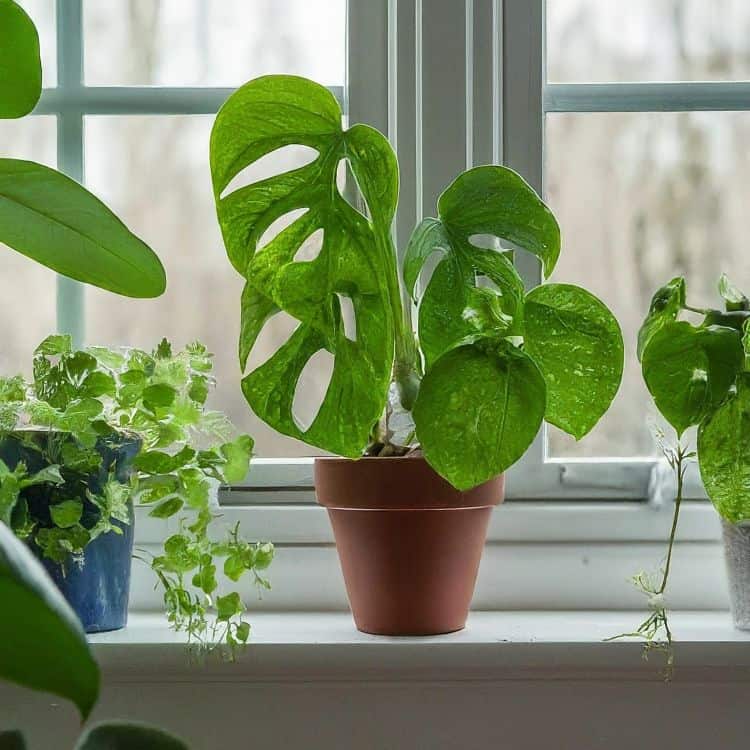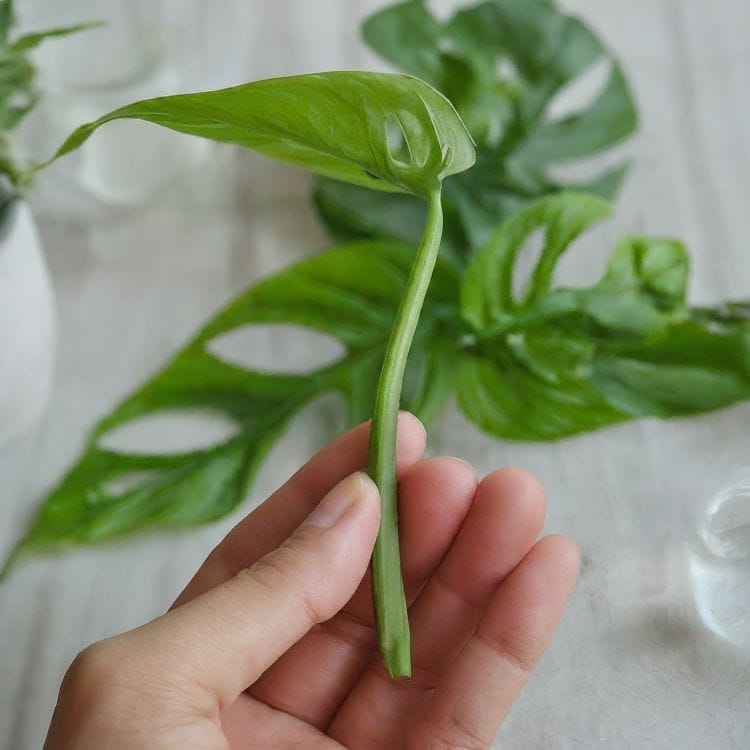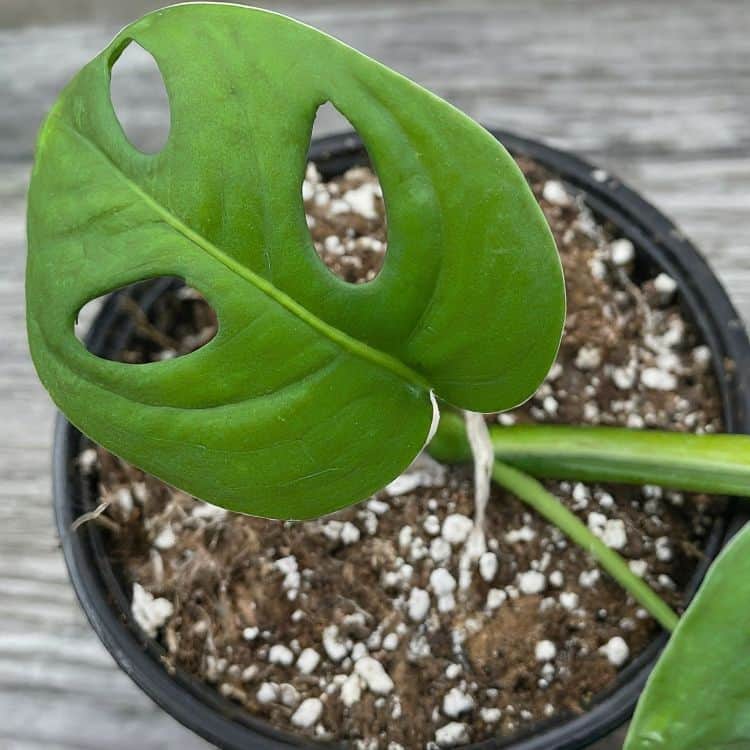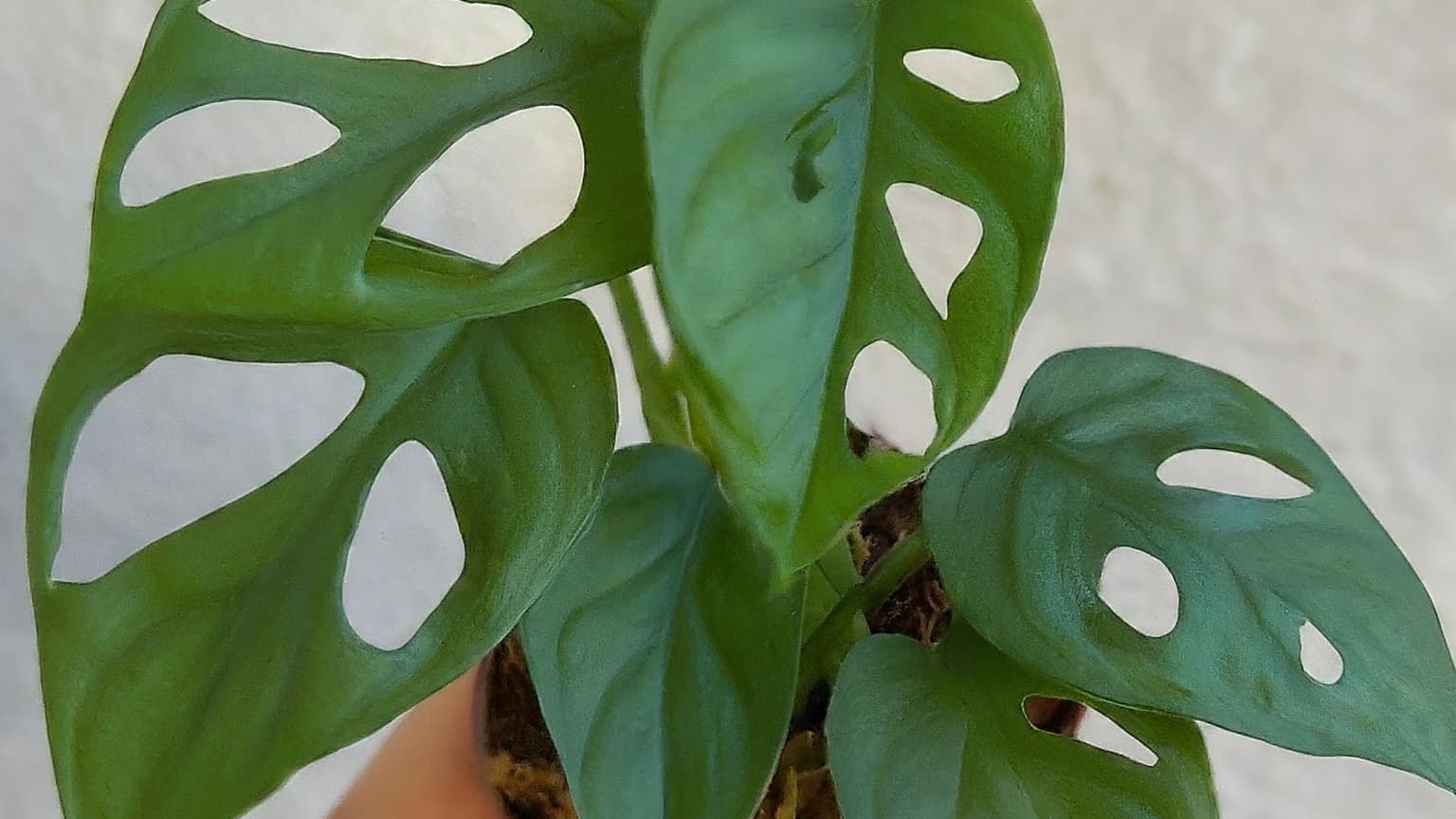The Mini Monstera, also known as Rhaphidophora tetrasperma, is a captivating indoor plant with beautiful, holey leaves similar to its larger cousin, the Monstera deliciosa. Originating from Southeast Asia, it’s not a true Monstera but belongs to a different plant family. Its small size makes it perfect for indoor spaces, and it’s known for climbing, which adds a nice touch to shelves or bookcases.
Even though it’s not a real Monstera, taking care of this plant is pretty similar. It likes partial sunlight, soil that drains well, and moderate temperatures. The cool thing is, that you can easily grow more plants from clippings! Just snip off a piece and put it in some soil, and you’ll have a new plant in no time. There are also some fancy variegated types if you want something extra special. Overall, the Mini Monstera is a delightful plant that brings a touch of the tropics to any indoor space.
Contents
5 Types of mini monstera

When it comes to Mini Monsteras, there’s more than meets the eye. While the classic Rhaphidophora tetrasperma steals the spotlight with its fenestrated leaves and compact size, there are several intriguing variations and cultivars that plant enthusiasts adore and
Each type brings its unique characteristics and appeal, offering plant enthusiasts a diverse array of options to explore.
Variegated Mini Monstera (Rhaphidophora tetrasperma variegata):
This stunning variation features leaves adorned with striking white or yellow variegation, adding a touch of whimsy to its tropical charm. Highly sought after for its unique appearance, it is a prized addition to any indoor plant collection.
Mini Monstera ‘Thai Constellation’:
With its marbled white and green leaves reminiscent of a starry night sky, the ‘Thai Constellation’ cultivar is a mesmerizing sight to behold. This rare and coveted variety stands out with its celestial foliage, making it a favorite among collectors seeking something truly extraordinary.
Mini Monstera ‘Mint’:
As its name suggests, the ‘Mint’ cultivar showcases leaves in refreshing shades of green with a hint of minty freshness. This delightful variation adds a pop of color to indoor spaces while retaining the classic Mini Monstera charm.
Mini Monstera ‘Albo Monstera’:
Similar to its larger counterpart, the Monstera deliciosa ‘Albo Variegata,’ this cultivar features leaves adorned with striking white variegation. The ‘Albo Monstera’ Mini version offers all the allure of its larger relative in a more compact package, making it ideal for smaller spaces.
Mini Monstera ‘Green Dragon’:
With its deeply serrated leaves resembling the scales of a dragon, the ‘Green Dragon’ cultivar exudes an air of mystique and intrigue. This unique variation adds a touch of drama to any plant collection, captivating onlookers with its exotic foliage.
6 Care Tips for Mini Monstera
Caring for a Mini Monstera requires attention to a few key factors:
Light:
Mini Monsteras thrive in bright and indirect light, making them perfect for spots near a window with sheer curtains or in well-lit rooms. Direct sunlight should be avoided because it can burn their delicate leaves. If you notice your Monstera’s leaves becoming pale or its growth becoming leggy, it’s a sign that it may need more light. Consider moving it to a brighter location or supplementing its light with a grow light to ensure its continued health and vibrancy. Remember, finding the right balance of light is key to keeping your Mini Monstera happy and thriving.
Watering:
Like many tropical plants, Mini Monsteras prefer regular moisture except for soggy soil. Water thoroughly when the top of the potting soil feels dry when touched, and ensure proper drainage to prevent root rot. It’s essential to water consistently to maintain its health and vitality. However, overwatering can lead to issues such as root rot, so it’s crucial to strike the right balance. Additionally, consider using room temperature water, as cold water can shock the plant’s roots. Remember, a well-hydrated Mini Monstera will reward you with lush, vibrant foliage.
Humidity:
These plants appreciate high humidity, which mimics their native rainforest environment. To increase humidity, consider keeping a humidifier near the misting leaves. Alternatively, you can place the pot on a tray filled with pebbles and water. Maintaining adequate humidity levels is essential for its overall health and well-being. Without sufficient moisture in the air, its leaves may start to develop brown edges or become crispy. By providing the right humidity conditions, you’ll ensure your Mini Monstera thrives and maintains its lush appearance. Remember, consistency is key when it comes to humidity levels for indoor plants.
Temperature
Mini Monsteras prefer warm temperatures between 18°C to 27°C. Avoid keeping them in cold places or sudden temperature changes. Maintaining a stable temperature is crucial for your plant’s well-being, as it can become stressed if subjected to extreme temperature variations. Cold drafts, in particular, can lead to leaf damage and hinder growth. A consistent and comfortable temperature range will create an optimal environment for your Mini Monstera to thrive. Additionally, consider the plant’s placement within your home, ensuring it’s away from air vents or windows where temperature fluctuations are more likely to occur.
Soil:
Well-draining, peat-based potting mix is ideal for Mini Monsteras. You can also add perlite or orchid bark to improve aeration. Ensuring proper soil composition is essential for Mini Monstera’s root health and overall growth. The well-draining nature of the mix prevents waterlogging, which can lead to root rot, while the addition of perlite or orchid bark enhances aeration, promoting robust root development. Remember to repot your Monstera plant every couple of years to refresh the soil and provide ample space for its expanding root system.
Fertilization:
Feed your Mini Monstera with a balanced liquid fertilizer diluted to half strength every 4-6 weeks during the growing season (spring and summer). Reduce fertilization frequency in fall and winter when growth slows down. Fertilizing your Mini Monstera provides essential nutrients to support its growth and vitality. During the active growing season, regular fertilization ensures the plant has access to the nutrients it needs to produce healthy foliage. However, as growth naturally slows down in the fall and winter months, it’s essential to adjust the fertilization frequency accordingly to prevent nutrient buildup in the soil. Following a consistent fertilization schedule will help your Mini Monstera thrive year-round.
Propagating Mini Monstera
Propagating Mini Monsteras can be an enjoyable way to expand your plant collection or share the beauty of these charming specimens with friends and family. Here are two common propagation techniques:
Stem Cuttings:

Stem cuttings are a simple and effective way to propagate Mini Monsteras. Here’s how to do it:
- Select a healthy plant stem with one or two leaf nodes. Nodes are the small bumps on the stem where leaves and roots emerge.
- Using clean and sterilized pruning shears or sharp scissors, make a clean cut below the node, ensuring the cutting is at least a few inches long.
- Remove any leaves from the lower part of the cutting to expose the node.
- Place the cutting stem in a moist soil mix or a container filled with water, make sure the node is fully submerged or fully covered with soil.
- Keep the cutting in a humid environment or warm with indirect sunlight. You can cover the container with a plastic bag or use a propagator to maintain high humidity levels.
- Roots should start to develop after a few weeks. When the roots are well-established, you can transplant the cutting into its pot with well-draining potting soil.
Air Layering:

Air layering is another propagation method that works well for Mini Monsteras, especially if you want to propagate a larger plant without taking cuttings. Here’s how to do it:
- Select a healthy stem on the parent plant, preferably one with existing aerial roots.
- Using a clean knife, make a diagonal cut halfway through the stem, just below a node where aerial roots are present.
- Gently pull the cut section of the stem away from the main plant, creating a small gap.
- Pack the gap with moist sphagnum moss or a mixture of sphagnum moss and potting soil.
- Wrap the moss or soil mixture around the cut section of the stem and cover it with plastic wrap to retain moisture.
- Check the moss or soil mixture regularly to ensure it stays moist.
- Roots should start to form within a few weeks. Once the roots are well-developed, you can cut the stem below the rooted section and transplant it into its pot with well-draining soil.
FAQs
How often should I water my Mini Monstera?
It prefers consistently moist but not soggy soil. Water thoroughly when the top inch of soil feels dry to the touch, typically every 1-2 weeks depending on environmental factors like temperature and humidity.
Can I place my Mini Monstera in direct sunlight?
It can thrive in bright, indirect light. Avoid placing them in direct sunlight, as this can scorch their delicate leaves. Opt for locations near windows with sheer curtains or in well-lit rooms instead.
What should I do if my Mini Monstera’s leaves start turning brown?
Browning leaves can be a sign of insufficient humidity or overwatering. Increase humidity by misting leaves regularly or placing the plant on a tray of pebbles and water. Ensure proper drainage to prevent overwatering, and adjust watering frequency accordingly.
How can I propagate my Mini Monstera?
Monstera plants can be propagated through stem cuttings or air layering. Stem cuttings involve snipping a healthy stem with at least one leaf node and rooting it in water or moist soil. Air layering entails creating a small incision in a stem, packing it with moist moss, and allowing roots to form before separating the new plant.
What is the ideal temperature range for Mini Monsteras?
These prefer warm temperatures between 18°C to 27°C. Avoid keeping them in cold places or sudden temperature changes, as this can stress the plant and hinder its growth.
Cultivating Mini Monstera
In summary, Mini Monsteras offer a captivating addition to indoor plant collections with their tropical charm and manageable care requirements. From their origins in Southeast Asia to their various cultivars and propagation techniques, these plants delight enthusiasts of all levels. With proper care and attention to light, water, humidity, temperature, soil, and fertilization, they can thrive and multiply effortlessly. Whether you’re an experienced plant parent or a novice, Mini Monsteras promises a touch of the tropics and enduring beauty in any indoor space.

